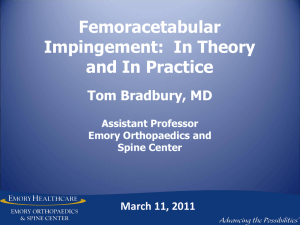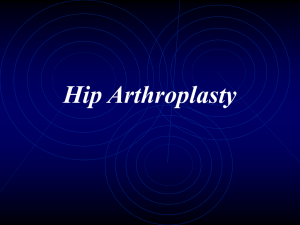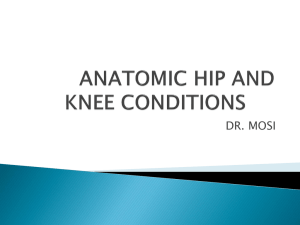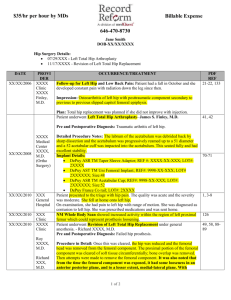Article
advertisement
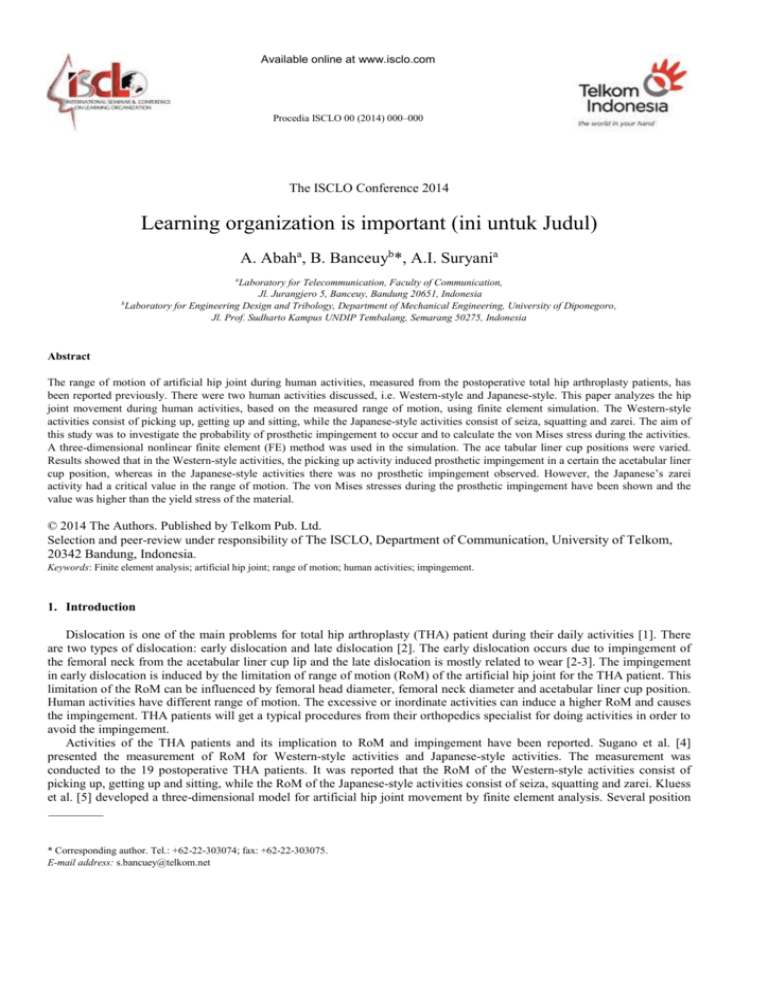
Available online at www.isclo.com Procedia ISCLO 00 (2014) 000–000 The ISCLO Conference 2014 Learning organization is important (ini untuk Judul) A. Abaha, B. Banceuyb*, A.I. Suryania a Laboratory for Telecommunication, Faculty of Communication, Jl. Jurangjero 5, Banceuy, Bandung 20651, Indonesia b Laboratory for Engineering Design and Tribology, Department of Mechanical Engineering, University of Diponegoro, Jl. Prof. Sudharto Kampus UNDIP Tembalang, Semarang 50275, Indonesia Abstract The range of motion of artificial hip joint during human activities, measured from the postoperative total hip arthroplasty patients, has been reported previously. There were two human activities discussed, i.e. Western-style and Japanese-style. This paper analyzes the hip joint movement during human activities, based on the measured range of motion, using finite element simulation. The Western-style activities consist of picking up, getting up and sitting, while the Japanese-style activities consist of seiza, squatting and zarei. The aim of this study was to investigate the probability of prosthetic impingement to occur and to calculate the von Mises stress during the activities. A three-dimensional nonlinear finite element (FE) method was used in the simulation. The ace tabular liner cup positions were varied. Results showed that in the Western-style activities, the picking up activity induced prosthetic impingement in a certain the acetabular liner cup position, whereas in the Japanese-style activities there was no prosthetic impingement observed. However, the Japanese’s zarei activity had a critical value in the range of motion. The von Mises stresses during the prosthetic impingement have been shown and the value was higher than the yield stress of the material. © 2014 The Authors. Published by Telkom Pub. Ltd. Selection and peer-review under responsibility of The ISCLO, Department of Communication, University of Telkom, 20342 Bandung, Indonesia. Keywords: Finite element analysis; artificial hip joint; range of motion; human activities; impingement. 1. Introduction Dislocation is one of the main problems for total hip arthroplasty (THA) patient during their daily activities [1]. There are two types of dislocation: early dislocation and late dislocation [2]. The early dislocation occurs due to impingement of the femoral neck from the acetabular liner cup lip and the late dislocation is mostly related to wear [2-3]. The impingement in early dislocation is induced by the limitation of range of motion (RoM) of the artificial hip joint for the THA patient. This limitation of the RoM can be influenced by femoral head diameter, femoral neck diameter and acetabular liner cup position. Human activities have different range of motion. The excessive or inordinate activities can induce a higher RoM and causes the impingement. THA patients will get a typical procedures from their orthopedics specialist for doing activities in order to avoid the impingement. Activities of the THA patients and its implication to RoM and impingement have been reported. Sugano et al. [4] presented the measurement of RoM for Western-style activities and Japanese-style activities. The measurement was conducted to the 19 postoperative THA patients. It was reported that the RoM of the Western-style activities consist of picking up, getting up and sitting, while the RoM of the Japanese-style activities consist of seiza, squatting and zarei. Kluess et al. [5] developed a three-dimensional model for artificial hip joint movement by finite element analysis. Several position * Corresponding author. Tel.: +62-22-303074; fax: +62-22-303075. E-mail address: s.bancuey@telkom.net A. Abah / Procedia ISCLO 00 (2014) 000–000 of the acetabular liner cup during the movement was simulated in order to observe the occurrence of impingement. This paper presents a 3D movement simulation to study the RoM of the Western-style and Japanese-style activities. The impingement is then predicted by a finite element analysis. The relation of the resisting moment, the internal rotation and the von Mises stress are reported in this paper. 2. Material and Method 2.1. Material model The finite element model of the contact system in the present study consists of femoral head, femoral neck and acetabular liner cup. The femoral head and the femoral neck component are assumed to be analytically rigid. The acetabular liner cup component is modeled as an elastic-plastic material with isotropic hardening for assuming a visco-elastic-plastic property of the ultra-high-molecular-weight polyethylene (UHMWPE). The elasticity modulus, the Poisson’s ratio and the yield strength of the UHMWPE are 945 MPa, 0.45 and 23.56 MPa, respectively [6]. The plastic strain is calculated based on the work of Fregly et al. [7]: 1 1 0 0 2 0 2 0 n (1) where the material parameter, n, is equal to 3. 2.2. Finite element method 2.2.1. Geometry a) b) Fig. 1. a) Model of the femoral head and the acetabular liner cup and b) finite element meshes of the acetabular liner cup. The geometrical modeling of the unipolar artificial hip joint follows the model of Kluess et al. [5], as is depicted in Fig. 1(a). Diameter of the femoral head and the femoral neck are 28 mm and 14 mm, respectively. The thickness of the acetabular liner cup is 7 mm. A gap between the femoral head and the acetabular liner cup is 24 µm and it is modeled as a lubrication space. Figure 1(b) shows the finite element meshes for the acetabular liner cup. The commercial finite element software ABAQUS is employed. The model uses the hexahedral 8 nodes linear brick (C3D8R) for modeling the element. The number of the element is 9088. 2.2.2. Boundary conditions The amount of the applying load of the present model adopts the work of Kluess et al. [5], but the direction of the load follows the work of Bergmann et al. [8]. The loads in the x, y and z directions are Fx = 15 N, Fy = 270 N and Fz = -427.5 N, respectively, and are applied on a point at the center of the femoral head. All the degree of freedom at the outer surface of the acetabular liner cup is constrained. The simulation is conducted in two steps: firstly, the load is applied to the center of the femoral head with constraining the rotation of the femoral head is constrained and secondly, the load at the center of the A. Abah / Procedia ISCLO 00 (2014) 000–000 femoral head is constrained with rotating the femoral head. The range of the rotation is according to the RoM of human activities. 2.2.3. Human activities The simulations are performed for the Western-style and the Japanese-style activities. Here, the value of the RoM is taken based on the work of Sugano et al. [4]. The Western-style activities consist of picking up an object while sitting on the chair, getting up from the chair, and sitting down on the chair. The Japanese-style activities consist of bowing while sitting on legs with fully flexed at the knee (zarei), squatting, and sitting on legs with fully flexed at the knee (seiza). Figures for expressing all these activities can be seen in [4]. Those activities give a certain value of the RoM in degree. Maximum flexion, adduction and internal rotation are the component items for the RoM value. Table 1 shows the value of RoM for the human activities. Table 1. Hip joint angle during human activities [4] Average ± Standard deviation Maximum Flexion Adduction Internal Rotation Motion, Degree Western-style activities on the chair Picking up an object while sitting on the chair 86 ± 13 −6.1 ± 7.3 −12 ± 11 Getting up from the chair 76 ± 12 −2.5 ± 5.2 −11 ± 10 Sitting down on the chair 62 ± 10 −0.92 ± 5.5 −7.0 ± 11 Japanese-style activities on the floor Bowing while sitting on legs fully flexed at the knee (zarei) 84 ± 13 −2.1 ± 4.9 −12 ± 11 Squatting 80 ± 16 −8.6 ± 9.5 −9.2 ± 11 Sitting on legs fully flexed at the knee (seiza) 61 ± 12 −1.2 ± 4.4 −15 ± 11 2.2.4. Variation The variation of the angle between inclination and anteversion of the acetabular liner cup is simulated to study the possibility of the impingement to occur between the femoral neck and the acetabular liner cup lip. The variation of inclination of the acetabular liner cup are 45o and 60o and the variation of anteversion of the acetabular liner cup are 15o and 30o. The angle of the femoral neck axis line and the femoral stem axis line is 135o. The simulation uses a femoral head diameter of 28 mm. The variation in the present study follow the work of Kluess et al. [5]. 3. Results and discussions 3.1. Validation In order to check the developed model simulation, a validation was conducted by comparing the results to the work of Kluess et al. [5]. The inclination and anteversion of the acetabular liner cup are fixed for 60o and 30o, respectively. Result of the validation is shown in Fig. 2. The average deviation between the present model and the Kluess et al. model is about 1.32 %. A good agreement is found in this validation. 3.2. Western-style activities Figure 3(a) and 3(b) show the degree of impingement for the Western-style activities. In Fig. 3(a) the internal rotation for the picking-up, getting-up and sitting down activities is reported with considering four different position of the acetabular liner cup. The minimum requirement of the internal rotation for picking-up, getting-up and sitting down activities are 12, 11 and 7, respectively. The highest resisting moments for picking-up, getting-up and sitting down activities are 4.41 Nm, 3.88 Nm and 3.21 Nm as is depicted in Fig. 3(b). Mostly, with the unipolar artificial hip joint model as proposed, the Western-style activities do not induce an impingement. The picking up activity, for the acetabular liner cup inclination of 45 and anteversion of 15, is the most critical activity because the impingement is predicted to be occur at 8 of the internal rotation. Therefore, the patients of A. Abah / Procedia ISCLO 00 (2014) 000–000 THA cannot finishing the picking up activity due to the fact that the picking up activity needs at least 12 of internal rotation. Figure 4 shows the von Mises stress analysis. Fig. 4(a) shows the stress analysis for getting up activity and Fig. 4(b) shows the picking up activity where the combination degree of the acetabular liner cup inclination and the anteversion is 45-15. Two impingement positions can be analyzed based on this figure, namely impingement site and egress site. Dislocation is predicted to be occur for the patients which are trying to perform the picking up activity. The other combination positions of the acetabular liner cup for inclination and anteversion are also reported in a safe position, 4530, 60-15 and 60-30. However, based on several testimonies of the orthopedic specialist it is stated that the inclination and the anteversion of the acetabular liner cup combinations of 45-15 is mostly used. It is suggested that the unipolar artificial hip joint, proposed by Kluess et al. [5], need to be redesigned to accommodate the picking up activity with respect to the inclination and the anteversion of the acetabular liner cup combination of 45-15. Fig. 2. Comparison between the present model and the Kluess model in predicting the resisting moment as a function of the angle of internal rotation. a) b) Fig. 3. a) Comparison of the calculated value of internal rotation obtained from variations of the acetabular liner cup position in the Western-style activities and b) plot of its resisting moment as a function of its internal rotation angle. impingement site egress site a) b) Fig. 4. The von Mises stress for: a) getting up activity and b) picking up activity where the acetabular liner cup position is 45° inclination and 15° anteversion of the Western activity. A. Abah / Procedia ISCLO 00 (2014) 000–000 3.3. Japanese-style activities The degree of impingement for the Japanese-style activities is shown in Fig. 5. In Fig. 5(a) the internal rotation for the three activities is reported with considering four positions of the acetabular liner cup. The minimum requirements of the internal rotation for zarei, squatting and seiza activities are 12, 9.2 and 15, respectively. Fig. 5(b) shows that the highest resisting moment for zarei, squatting and seiza activities are 4.33 Nm, 4.10 Nm and 3.15 Nm, respectively. In general, with the proposed unipolar artificial hip joint model the Japanese-style activities are predicted safe in term of the impingement. However, the zarei activity, for inclination of 45 dan anteversion of 15 of the acetabular liner cup, is still not suggested. This because the impingement of the zarei activity is predicted to be occurr at 13.53 of internal rotation while the result shows that the required degree of the zarei activity is 12o. Moreover, the safe margin of the internal rotation is about 10 as was suggested by Sugano et al. [4]. Therefore, an evaluation is still needed for the unipolar artificial hip joint model proposed by Kluess et al. [5]. The model needs to be redesigned for accommodating the zarei activity in a more safe condition. The von Mises stress analysis for the Japanese-style activities are shown in Fig. 6(a) and 6(b) for squatting and zarei activities with the combination of inclination and anteversion of the acetabular liner cup of 45-15. a) b) Fig. 5. a) Comparison of the calculated value of internal rotation obtained from variation of the acetabular liner cup position in the Japanesestyle activities and b) plot of its resisting moment as a function of its internal rotation angle. a) b) Fig. 6. The von Mises stress for: a) squatting activity and b) zarei activity where the acetabular liner cup position is 45° inclination and 15° anteversion of the Western activity. 4. Conclusion This paper investigated the range of motion of the human activities of the Western-style and the Japanese-style using finite element analysis for THA patient. The unipolar artificial hip joint model was used in the simulation. Based on the results it can be stated that for the THA patients the Western-style and Japanese-style activities can be performed safely. A. Abah / Procedia ISCLO 00 (2014) 000–000 The impingement and dislocation are predicted to be occur at picking up activity in the Western-style activity for the inclination and anteversion combination of the acetabular liner cup of 45-15. The seiza activity in the Japanese-style activitiy is not recommended to be performed for the THA patients because of the safety margin of the internal rotation is less than 10. The impingement between the femoral neck and the acetabular liner cup lip during a contact situation can be predicted by the finite element simulation. It is also demonstrated that the von Mises stress at the impingement position is higher than the yield strength of the material. References [1] Sikes, C.V., Lai, L.P., Schreiber, M., Mont, M.A., Jinnah, R.H., Seyler, T.M., 2008. Instability After Total Hip Arthroplasty Treatment with Large Femoral Heads vs Constrained Liners, the Journal of Arthroplasty, Vol. 23, No.7, pp. 59-63. [2] Cuckler, J.M., 2011. The Dislocated Total Hip: The Dreaded 3 AM Phone Call, Seminars in Arthroplasty 22, pp. 98-99. [3] Hummel, M.T., Malkani, A.L., Yakkanti, M.R., Baker, D.L., 2009. Decreased Dislocation After Revision Total Hip Arthroplasty Using Larger Femoral Head Size and Posterior Capsular Repair, the Journal of Arthroplasty, Vol. 24, No. 6, pp. 73-76. [4] Sugano, N., Tsuda, K., Miki, H., Takao, M., Suzuki, N., Nakamuro, N., 2012. Dynamic Measurements of Hip Movement in Deep Bending Activities After Total Hip Arthroplasty Using a 4-Dimensional Motion Analysis System, the Journal of Arthroplasty, Vol. 27, No. 8, pp. 1562-1568. [5] Kluess, D., Martin, H., Mittelmeier, W., Schmitz, K.P., Bader, R., 2007. Influence of Femoral Head Size on Impingement, Dislocation and Stress Distribution in Total Hip Replacement, Medical Engineering & Physics 29, pp. 465-471. [6] Eichmiller, F.C., Tesk, J.A., Croarkin, C.M., 2001, Mechanical Properties of Ultra High Molecular Weight Polyethylene NIST Reference Material RM 8456, In: ‘Transactions of the Society for Biomaterials, 27th Annual Meeting’, p. 472. [7] Fregly, B.J., Bei, Y., Sylvester, M.E., 2003. Experimental Evaluation of An Elastic Foundation Model to Predict Contact Pressures in Knee Replacements, Journal of Biomechanics 36, pp. 1659-1668. [8] Bergmann, G., Graichen, F., Rohlmann, A., 1993. Hip Joint Loading During Walking and Running, Measured in Two Patients, Journal of Biomechanics 26, pp. 969- 990.
